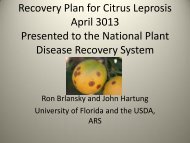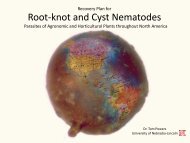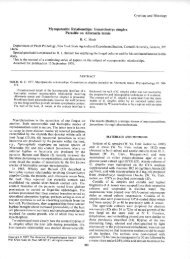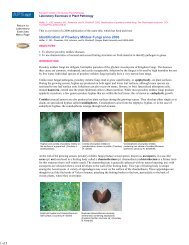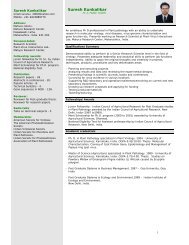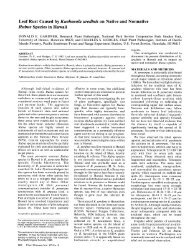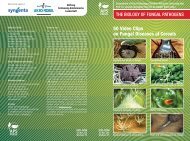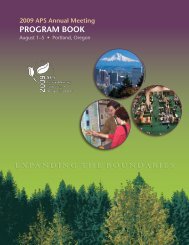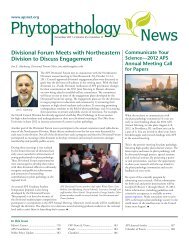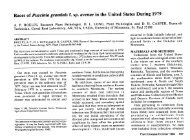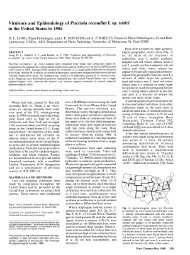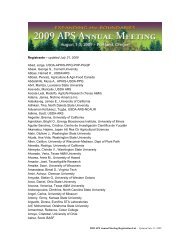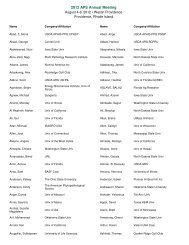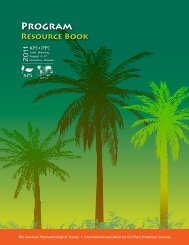view article - American Phytopathological Society
view article - American Phytopathological Society
view article - American Phytopathological Society
You also want an ePaper? Increase the reach of your titles
YUMPU automatically turns print PDFs into web optimized ePapers that Google loves.
causes soft rot disease of potatoes, was investigated for 169<br />
production of a catechol siderophore. Catechol production was<br />
detected colorimetrically, by bioassay, and by homology to THE HYPERSENSITIVE RESPONSE<br />
genes<br />
IS<br />
determining<br />
ELICITED BY ESCHERICHIA<br />
biosynthesis<br />
COLI<br />
of enterochelin, the catechol CONTAINING A CLUSTER OF PATHOGENICITY<br />
siderophore<br />
GENES<br />
of<br />
FROM<br />
Escherichia<br />
ERWINIA<br />
coli. Results suggested that strain AMYLOVORA. S. V.<br />
W3C105<br />
BEER;<br />
produces<br />
C. H. ZUMOFF;<br />
a catzechol<br />
D. W.<br />
siderophore<br />
BAUER; B. J.<br />
with<br />
SNEATH;<br />
functional and R. J. LABY. Department of Plant Pathology,<br />
similarity<br />
Cornell<br />
to enterochelin. Genes involved in catechol University, Ithaca, NY 14853 U.S.A.<br />
production were identified from a genomic library of strain<br />
W3C105 in E. coli strain AN192, which is deficient in Hrp mutants of E. amylovora<br />
enterochelin<br />
are deficient<br />
production.<br />
in<br />
Three<br />
both pathogenicity<br />
clones producing a catechol to pear fruit and the ability to<br />
were<br />
elicit<br />
detected<br />
the hypersensitive<br />
on a universal siderophore-detection medium, response in tobacco.<br />
These<br />
A cosmid,<br />
clones<br />
pCPP430,<br />
provided<br />
containing<br />
iron to enterochelin-deficient<br />
wild-type<br />
indicator DNA of E. amylovora, was<br />
strains.<br />
identified<br />
The<br />
that<br />
role<br />
restores<br />
of catechol<br />
pathogenicity<br />
siderophore production in the and HR-eliciting ability to 18 transposon-induced<br />
pathogenicity and<br />
Hrpecology<br />
and two<br />
of E. carotovora will be evaluated, naturally occurring Hrp- mutants. pCPP430 contains a cluster of<br />
hrp genes, dispersed throughout a 45 kb region of chromosomal<br />
DNA. When Escherichia coli, strain DH5, containing pCPP430, was<br />
infiltrated into tobacco-leaf tissue, strong collapse occurred<br />
extremely rapidly. In addition, the cosmid conferred<br />
166 HR-eliciting ability (in tobacco), to several other species of<br />
CHARACTERIZATION OF AN rcsA-LIKE GENE OF<br />
Erwinia.<br />
ERWINIA<br />
Theseresults<br />
AMYLOVORA THAI<br />
clearly indicate<br />
all the<br />
that<br />
genes<br />
pCPP430<br />
needed<br />
contains<br />
for elicitation<br />
STIMULATES<br />
of<br />
EXTRACELLULAR<br />
the HR, and that<br />
POLYSACCHARIDE<br />
they<br />
(EPS) PRODUCTION IN are expressed in E. coli and in other Erwinia species.<br />
ERWINIA SPP. AND OTHER ENTEROBACTERIA. W. Chun, A. Chatterjee.<br />
R. N. Goodman and A. K. Chatterjee, Department of Plant<br />
Pathology, University of Missouri-Columbia, Columbia, MO 65211. 170<br />
EPS production by E. amylovora is required in the elicitation of CHARACTERIZATION OF PROMOTER-ACTIVE FRAGMENTS FROM<br />
the fire-blight disease in apples and pears. To examine the XANTHOMONAS USING A NEW BROAD HOST RANGE PROMOTER<br />
regulation of EPS biosynthesis, we obtained from an E. amylovora SELECTION VECTOR. S. Swarup, R. DeFeyter and D.W. Gabriel.<br />
cosmid library, several E. coli (HB1OI) clones that were mucoid Plant Pathology Dept., University of Florida, Gainesville, FL 32611.<br />
on agar plates. The complementation of an rcsA mutation in E.<br />
coli and the stimulation of EPS production in various A broad host-range (Inc Q) promoter selection vector, pUFC600, was<br />
enterobacteria (E. amylovora, E. stewartii, E. coli, and<br />
Salmonella typhimurium) associate the mucoid phenotype conferred constructed that enables a direct selection of promoter-active fragments.<br />
by the cloned DNA to an E. amylovora regulator gene. This pUFC600 is 9.4 kb in size, Knr, has a promoterless Smr gene, multiple<br />
rcsA-like gene along with its own promoter has been localized on cloning sites and tandem transcriptional terminators upstream of the cloning<br />
a-2.2 kb DNA segment. Nucleotide sequence homology determined by sites. In the absence of any promoter-active fragment, E. coil strain DH5x<br />
Southern hybridizations and functional complementation of the and Xanthomonas strains containing the plasmid were sensitive to<br />
mucoid phenotype by the cloned DNA indicate that the genes for streptomycin at 15 pg/ml in minimal and 25 pg/ml in complete media. A<br />
the regulation of EPS biosynthesis have been conserved in these genomic library (-4 kb insert size) of X. citri strain 3213 was constructed<br />
enterobacteria. in pUFC600. Clones were introduced into X.c. pv. citrumelo strain 3048 Spr<br />
at an average frequency of 10-4 per recipient. Promoter activity was<br />
selected or screened on both minimal and complete media with<br />
streptomycin and various classes of promoter active fragments were<br />
identified. The relationship of pathogenicity genes to promoter-active<br />
167 fragments which were induced on minimal media will be discussed.<br />
CLONING OF AN AVIRULENCE GENE FROM PSEUDOMONAS SOLANACEARUI<br />
STRAIN AWl AND ITS INVOLVEMENT IN HOST RANGE. B. F. Carney and<br />
T. P. Denny, Dept. of Plant Pathology, UGA, Athens, GA 30602. 171<br />
A locus responsible for the hypersensitive response (HR) in<br />
P. solanacearum strain AWl (avirulent on tobacco, but pathogenic<br />
on tomato) was cloned by complementation in P. solanacearum<br />
strain K601 (pathogenic on tobacco and tomato). Pseudomonas<br />
solanacearum K601 transconjugants [ K601(pBC73) and K601(pBC62)<br />
] were nonpathogenic on tobacco, suggesting that cloned locus had<br />
the potential to restrict the host range of K601. DNA analysis<br />
of the clones pBC73 and pBC62 indicated that a common 4.2 Kb<br />
EcoRI/BamHI fragment was responsible for the induction of HR in<br />
K601 transconjugants. Transposon mutagenesis of the wild type<br />
locus in strain AWl resulted in the loss of HR on tobacco but<br />
retention of pathogenicity on tomato, indicating that this locus<br />
contains an avirulence gene. Pathogenicity on tobacco was not<br />
acquired upon inactivation of this avirulence gene in AWl,<br />
suggesting that AWl lacks positive acting host range genes that<br />
are required for pathogenicity on tobacco,<br />
168<br />
1682<br />
CLONING OF TWO GENES FOR PRODUCTION OF<br />
POLYSACCHARIDE<br />
EXTRAC ELLULAR<br />
FROM PSEUDOMONAS SOLANACEARUM AND THEIR<br />
CONTRIBUTION TO VIRULENCE. S. -R. Baek and T. P. Denny. Dept.<br />
of Plant Pathology, University of Georgia, Athens, GA 30602.<br />
Tn5-induced mutations of Xanthomonas campestris pv. citrumelo<br />
affecting pathogenicity and host-species specificity. .<br />
Kingsley and D.W. Gabriel. University of Florida, Gainesville,<br />
Florida 32611<br />
Tn5-induced mutations affecting pathogenicity (PATH-) and host<br />
species specificity (HSS-) were recovered in X. campestris pv.<br />
citrumelo. All 3048::Tn5 exconjugants (including auxotrophs)<br />
were screened on both bean and citrus. Auxotrophic mutations<br />
had significant effects in planta. For example, uracil<br />
auxotrophy resulted in a path- phenotype, while isoleucine-<br />
valine auxotrophs were hss- in bean but were relatively<br />
unaffected in citrus. None of the Tn5-inserts affecting<br />
pathogenicity or host range appeared to be clustered by<br />
hybridization analyses, nor did the affected DNA regions<br />
hybridize with the P. solanacearum hrp cluster (ie. pVir2). A<br />
high level of polymorphism was observed between, but not<br />
within 12 species or pathovars of Xanthomonas probed with<br />
HSS-related DNA fragments, which may indicate a lack of<br />
conservation of the gene(s) present at the affected loci.<br />
17<br />
MOLECULAR CHARACTERIZATION OF A LOCUS REGULATING PRODUCTION OF<br />
EXTRACELLULAR POLYSACCHARIDE SLIME AND VIRULENCE IN PSEUDOMONAS<br />
SOLANACEARUM. S. M. Brumbley and T. P. Denny, The University of<br />
Previous research had marked two loci of P. solanacearum<br />
AWl that<br />
strain<br />
are involved in the production of extracellular polysaccharide<br />
(EPS) with Tn5 insertions. These Tn5 insertions and<br />
flanking DNA of P. solanacearum were cloned and used to locate<br />
eight cosmid clones that contained homologous sequences in a<br />
genomic library of P. solanacearum AWl. The cosmids were<br />
restriction mapped and found to contain unique and overlapping<br />
regions that spanned a total of 55 kilobases; the Tn5 insertions<br />
in the two loci were centrally located and 12.5 kb apart. The<br />
Tn5 inactivated genes in strains AWl-l and AWI-41 were<br />
designated epsA and epsB, respectively. Seven of the eight<br />
cosmids completely restored EPS production to strain AWI-41.<br />
Three cosmids partially restored EPS production to strain AWl-l<br />
and these transconjugants were more virulent on tomato than was<br />
strain AWl-l. These results support the idea that EPS has a<br />
major role in P. solanacearum causing wilt symptoms on tomato.<br />
Georgia, Athens, GA 30602.<br />
A well known phenomenon of P. solanacearum is the<br />
spontaneous mutation from a mucoid to a nonmucoid form. A<br />
variety of other traits, including virulence, are affected. A<br />
previously isolated Tn5 mutant (AWI-80) is identical to the<br />
naturally occurring spontaneous mutant AWl-A in every way tested.<br />
An EcoRI fragment containing the Tn5 plus flanking DNA from AWl-<br />
80 was cloned and used as a hybridization probe to identify two<br />
cosmids from a genomic library of the wild type P. solanacearum<br />
strain (AWl). These cosmids restored wild type traits when<br />
conjugated into AWI-80, AWl-A and several other spontaneous<br />
avirulent mutants strains of P. solanacearum. These results<br />
suggest that this locus (designated rpc) contains a regulatory<br />
element(s) with global functions. This system does not appear<br />
to be the same as that regulating the production of alginate in<br />
Pseudomonas aeruginosa.<br />
1156 PHYTOPATHOLOGY



